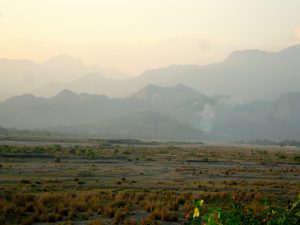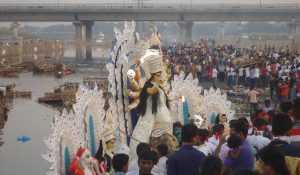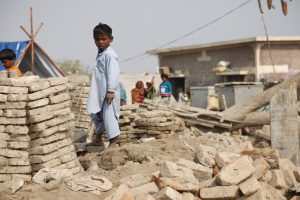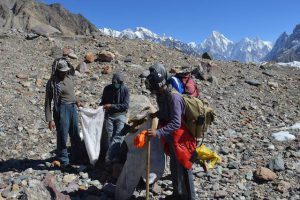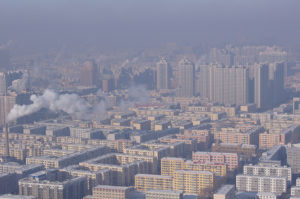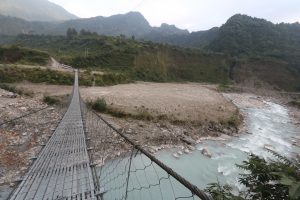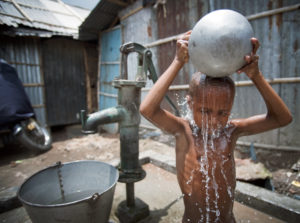Kolkata, the capital city of West Bengal, is the most important city for water supply in eastern India. The core Kolkata city is spread over around 200 square kilometres and has a population of 4.5 million people. It has also been one of the most water-abundant cities of India. The greater urban conglomeration includes 41 other cities and hosts nearly 15 million, making it the third largest city area in India.
According to Dhrubojyoti Ghosh, former chief environment officer of the state environment department now an expert with the International Union for Conservation of Nature, Kolkata is blessed ecologically because it has, “the Ganga flowing beside its western end, traditionally huge groundwater reserve and wide wetlands area in its eastern fringe which naturally treats its waste water and turns that as raw water for fishery and agriculture.” Despite these advantages the city is now increasingly running into trouble.
![The Ganga's flowing by makes Kolkata very water-rich. [image by Abhijit Kar Gupta]](https://dialogue.earth/content/uploads/2015/11/2nd-Hooghly-Bridge-Abhijit-Kar-Gupta.jpg)
In a confidential interview a Kolkata Municipal Corporation (KMC) official told thethirdpole.net that, despite having water connections, rich families living in newly constructed multi-story apartment blocks pump their own water. They do not have much faith on the quality of water supplied by civic bodies. The situation is even worse in smaller cities within Kolkata Metropolitan Area where the access to surface water is much less.
As a consequence of this groundwater levels have plummeted in various parts of the city. “We had carried out a detailed assessment of groundwater status in the city some years back and found that there had been sharp decline especially in central to south Kolkata as well as along EM Bypass where most high-rises have come up in recent years,” said Tapas Ghatak, an environment expert formerly with Kolkata Metropolitan Development Authority (KMDA).
Kolkata officially has about 17,000 stand posts (as water hydrants are referred to in the city), 12,000 hand tube wells and around 2,500 large tube wells mainly catering to multi-story buildings, but the actual figures are far higher. In the same vein, although officially commercial establishments and industries account for around one-fifth of the city’s water, the actual consumption is significantly higher.
The poor subsidise the rich
While the rich withdraw water from the ground, the situation for the poor is starkly different. More than 315 million gallons of drinking water daily is withdrawn daily from the KMC area, with a per capita consumption of nearly 200 litres per day. But there is a hidden catch in the numbers because this figure includes water withdrawn by both public and private sources. Nearly 35% of the city population lives in slums, who have limited access to public sources, and very rare access to private ones. They generally only receive drinking water through a few stand posts.
Most water is actually seized by the city’s middle and upper class as well as commercial establishments and the floating population – largely composed of migrant workers – of more than 5 million for various needs. The government policy of not charging people for water effectively means the poor subsidise the wealthy, explained water expert Professor Asit Biswas.
Supplying drinking water has become a big business in and around Kolkata, especially in areas with unsafe groundwater. For example, Madhusudhankati is a small hamlet at the northern fringe of Kolkata Metropolitan Area where groundwater is contaminated with arsenic. In the village nearly 200 families pay ten rupees every day to buy 20 litres of safe drinking water provided by non-profit Sulabh International. Rates are much higher in other areas where private companies operate.
Gobindo Mandal, who lives at outskirts of Sonarpur on the southern fringe of Kolkata, told thethirdpole.net, “In our area some private company has set up a water treatment plant and they sell at a rate of around 2 rupees per litre though there is no ISI stamping [showing that the product meets with official Indian standards]. The rate is nearly double in areas further out where water middlemen sell the same water.”
In striking contrast, the city dwellers do not have to shell out any water tax to corporation as a declared mandate of the West Bengal chief minister Mamata Banerjee. In 2011, Ms Banerjee’s Trinamool Congress Party had abolished the collection of water tax. This has, among other things, crippled the revenue to the municipal authorities, and boosted the activities of private water suppliers.
The private – and often illegal – water business is even the norm in Salt Lake in central Kolkata city where the drinking water quality is poor. “It is a common practice to puncture the water line of Kolkata municipal corporation area along EM Bypass, collect water in various containers and sell it to Salt Lake residents at a high rate. Everybody knows it but nobody can do anything as these water mafias have tactic political support”, explained a senior KMC official. KMC admits that only about 35% of drinking water actually reaches the 245,000 odd households it supplies.
Pollution does not help
Experts have pointed out that, apart from the dwindling supply, the quality of city’s groundwater is also under scrutiny due to spread of arsenic contamination as well as salinity incursion. According to School of Environmental Studies of Jadavpur University, nearly 55% of the city’s groundwater has “high levels” of arsenic compared to the World Health Organisation standard.
The drinking water supply also gets contaminated by leaking sewerage pipes. Industrial pollutants including heavy metals also leak into groundwater supplies. “There was an effort from the state pollution control board to ensure that industries treat effluent before disposing it into the sewer line but we have to accept that virtually nothing has been done on the ground,” stated a state pollution control board official.
Water supply: Fears for the future
With all these problems, the city is running towards an imminent water crisis. “There is a limit to supply of treated surface water if you do not introduce water charges and minimise water waste. With increasing demand the pressure will be more on groundwater, which in turn will further affect the quantity and quality of groundwater especially in context to continually decreasing water recharge due to increasing concretization … no doubt, despite traditionally having good water reserves we are entering into an era of water starvation in city,” observed an expert, pointing out that the stress has already started to show during peak water demand in summer.
Groundwater levels have dropped consistently over the ten year period from 1996 to 2006 in both pre and post-monsoon levels. Without revenue coming in from the water tax since 2011 the cost of producing drinking water is also not being recovered, making the system unsustainable in the long run.
“We are more or less okay till 2020 but beyond that the situation may become critical,” stated a senior KMC official. According to Professor Pradip Sikdar of the Indian Institute of Social Welfare and Business Management in Kolkata, the city’s groundwater demand may rise about 25% by 2025 from the present demand of around 310 million litres every day.
With a chief minister bent upon riding populist policy, who has ruled out a water tax, and political opponents who do not dare to disagree with her publicly, the water future of Kolkata city and its surrounding looks increasingly uncertain.
![<p>Man taking a bath from a Kolkata stand post water pipe. [image by Jorge Royan]</p>](https://dialogue.earth/content/uploads/2015/11/water-supply-Kolkata.jpg)


